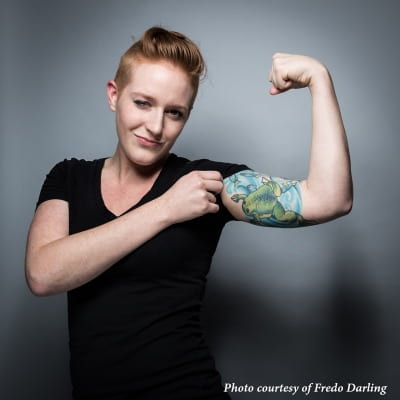Dr. Beth Bearce
Dr. Beth Bearce was a doctoral candidate in the Lowery Lab at Boston College when this interview was conducted. She has since successfully defended her dissertation. Beth studies the embryonic cells that later develop and differentiate to create almost all tissues of the face.
After the first round of Scientist Spotlight interviews, students requested hearing from current graduate students, so in the Spring of 2019, I enlisted the help of the undergraduate TAs to do the first grad student interviews.
In this interview, grad student Beth Bearce discusses her research in the Lowrey Lab at B.C. with teaching assistant Amanda Garza. Beth is now Dr. Bearce, having successfully defended her dissertation!
“I study the basic structural mechanics that allow these cells to move and infiltrate the regions that they need to populate in order to form craniofacial features, so I am quintessentially a cell biologist by training– but I am fascinated by this tissue’s niche in evolution as well. The idea that one cell type can go on to create so many different facial morphologies– from fish lips, to bird beaks, to human skulls, and everything between– is wild to me!”
Summer 2019 update from Dr. Bearce who graduated in May 2019:
I just moved all the way across the country to Eugene, Oregon (UO) to begin my postdoc! (Our lab website is here.) I’m working on a cell and developmental biology project. As a cell biologist, I like to study tiny parts and processes inside singular cells, and how these processes are instrumental in contributing to something larger than themselves– in my case, the development of a properly-formed embryo. The tiny piece of cellular machinery at the heart of my new work is called a cilium (plural: cilia). Cilia are little motile “batons” on the outside of many cells, which create flows of extracellular fluid– imagine a bunch of cells waving “hi,” and you can begin to picture how the cumulative motion of these things could move fluid around. We’ve known for some time now that these structures, and the flows that they generate, have a lot of really important roles in developing and adult tissues, but there are still a lot of questions about how these cilia are formed & orchestrated, how they “know” how to generate the right patterns of fluid flow, and why this matters in certain biological contexts. A famous physicist named Richard Feynman once said, “when it comes to understanding biology, just look at the damn thing.” (He was attempting to throw shade at our entire field; but, as biologists, we’ve developed a certain fondness for the statement.) So, in order to study cilia and development, I need something to look at– and the thing we look at (usually called a “model,” or “model organism”) is a tiny stripe-y fish, called the zebra danio, or zebrafish. You can find them for a dime or two at most pet stores. But these fish have a really important job– they’re helping me “look” at one particular role of cilia and development. Specifically, they’re helping us ask how embryos develop a straight and healthy spine. What does your big ol’ spine have to do with tiny, waving cilia? Great question. My boss found in some of his earlier work that many mutations in cilia genes give rise to fish with dramatic spinal curvatures– literally, fish with severe scoliosis. His work showed that CSF flow during certain windows of development seemed to “talk” to the developing spine (and neighboring muscles and neurons), and this communication was critical for spinal straightening. I am essentially using genetic techniques like CRISPR, as well as lots of fancy microscopy and micro-CT, to ask how this systemic communication between skeleton, muscle, and neurons (which all seem to have roles in developing a normal, non-scoliotic spine) is connected to a biophysical process– swirling fluid flows inside the early spine, and the tiny little “ciliary batons” that generate them.
